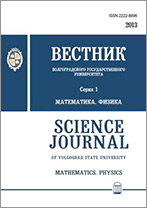|
Astrophysics
Numerical modelling of chemical and dynamic evolution of colliding HI clouds
P. V. Ivakhnenko, M. A. Eremin, V. V. Korolev
Volgograd State University
Abstract:
Interstellar clouds collisions have a strong influence on star formation, dissipation of kinetic energy and gaseous structure of galaxies. In addition, clouds collisions are one of the most important physical processes that are responsible for transitions between different phases of the interstellar medium and observed mass spectrum of diffuse HI clouds.
The main aim of the article is high resolution numerical simulations of diffusion clouds collisions in two dimensions in the frame of the self-consistent model. This approach implies concurrent consideration of dynamical, thermal and chemical processes in the interstellar medium with particular attention to formation of $H_2$ and $CO$ during clouds inelastic collisions. The approach of Nelson and Langer (1997) for modeling of chemistry of the interstellar medium was chosen. The thermal model of the interstellar medium includes the most relevant cooling and heating processes for temperature interval between $10$ and $2 \cdot 10^4$ К.
We assume that clouds are characterized by temperature $T_{cl} = 80$ К and number density $n_{cl} = 10 \,{\mathrm{sm}}^{-3}$, radius of the clouds are $1$ pc before collision. Initially clouds are in pressure equilibrium with the warm surrounding intercloud medium with temperature $T_{wim} = 8 000$ К, $n_{wim} = 0,1 \, {\mathrm{sm}}^{-3}$. The chemical composition of the clouds and intercloud medium is basically the same, except for $H_2$. The abundance of $H_2$ in clouds are $x(H_2) = 0,1$, all gas in intercloud medium is in the form of HI.
We have found that in radiative regime of head-on collisions of equal mass clouds the destruction of clouds takes place with formations of cold clouds filaments. The fractional abundance of $H_2$ in filaments does not exceeds $0,1$, $CO$ fraction is very small. In adiabatic regime of interaction clouds are destroyed completely, so all the clouds material is converted in warm phase of the ISM.
Keywords:
interstellar medium, chemical kinetics, gas dynamics, numerical methods, HI clouds.
Citation:
P. V. Ivakhnenko, M. A. Eremin, V. V. Korolev, “Numerical modelling of chemical and dynamic evolution of colliding HI clouds”, Vestnik Volgogradskogo gosudarstvennogo universiteta. Seriya 1. Mathematica. Physica, 2016, no. 6(37), 174–180
Linking options:
https://www.mathnet.ru/eng/vvgum156 https://www.mathnet.ru/eng/vvgum/y2016/i6/p174
|

| Statistics & downloads: |
| Abstract page: | 79 | | Full-text PDF : | 39 | | References: | 26 |
|




 Contact us:
Contact us: Terms of Use
Terms of Use
 Registration to the website
Registration to the website Logotypes
Logotypes







 Citation in format
Citation in format 